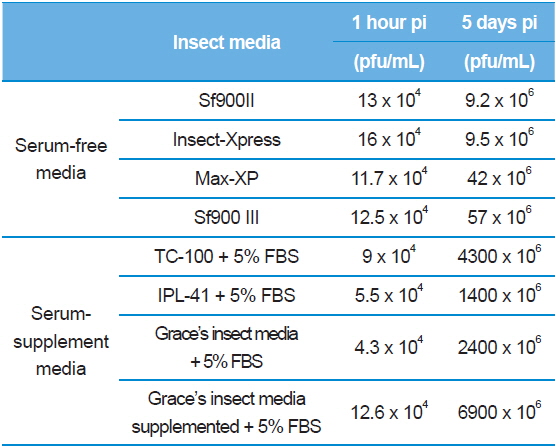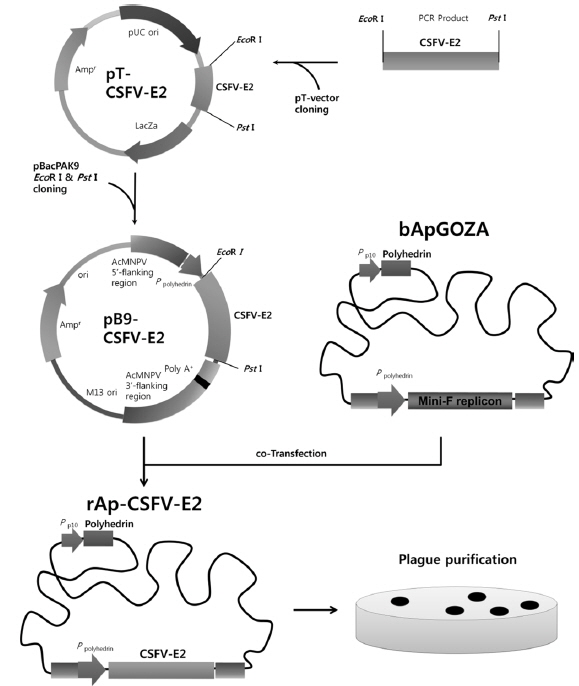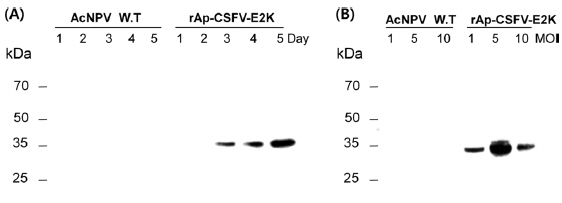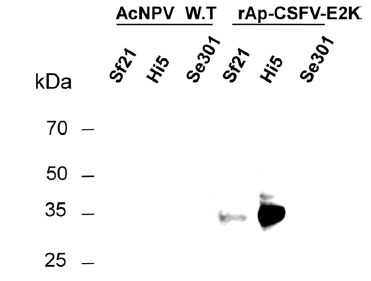



The baculovirus expression vector system (BEVS) is an effective and very popular used method for the production of recombinant proteins in insect cells. The baculovirus most often used as an expression vector is
Classical swine fever virus (CSFV), featuring high fever and hemorrhagic lesions, is a highly contagious disease threatening the pig industry of the world (Terpstra, 1991). CSFV is a member of the
In this study, with the aim of determining an effective cell line, p.i. time, MOI and cell culture media using BEVS, we analyzed the optimal expression conditions of recombinant glycoprotein E2. We constructed a recombinant AcNPV which contains a CSFV glycoprotein E2 with TMR gene. The glycoprotein E2 production in cells adapted to serum-free media and media with serum also was evaluated in three insect cell lines.
The basal insect cell line used was a strain of
The insect media used were serum-free and serumsupplemented media. The serum-free media were SF900II (Gibco, USA), SF900III (Gibco, USA), Insect-Xpress (BioWhittaker, USA) and MAX-XP (BD, USA). The serum-supplemented media were TC-100 (Welgene, Republic of Korea), IPL-41 (Welgene, Republic of Korea), Grace’s insect medium (JBI, Republic of Korea) and Grace’s insect medium supplemented (Gibco, USA). 5% of FBS was added.
>
Cloning and construction of recombinant virus
Viral RNA was extracted from CSFV-infected cell cultures with Viral Gene-spinTM kit (iNtRON Biotechnology, Republic of Korea) as recommended by the manufacturer. The viral RNA was used as a template for cDNA synthesis using RNA LA PCR Kit (TaKaRa, Japan). The glycoprotein E2 gene was amplified from cDNA with primers CSFV E2-F (5’-GAATTCATAATGCGGCTAGCCTGCAAGGAAGATT-3’) and CSFV-E2-R (5’-CTGCAGACCAGCGGCGAGTTGTTCTGTTAGAA-3’). The purified PCR products were cloned into the T&A cloning vector (RBC Bioscience, Taiwan), and the plasmids were named as pTA-E2 (Fig. 1). The plasmids were digested with
Recombinant virus titer was determined by an end-point dilution assay. In this method, 96-well plates containing 100 μL of cellular suspension at a density of 2×105 cells/mL were incubated for 1 h at 27˚C. Dilutions of the virus samples were performed serially in SF900II medium, from 1:103 to 1:108, and 100 μL were used to infect Sf21 cells monolayer after removing the medium from plate wells. Eight replicates for each dilution were performed in the same plate, and two independent plates were infected for each viral sample. SF900II medium was used as negative control. Plates were screened after seven days for occlusion bodies under a microscope. The 50% tissue-culture infectious dose (TCID50), i.e., the dilution which is sufficient to infect half of the cells, was calculated using equations described elsewhere (King and Possee, 1992). This value was then converted to plaque-forming units (or number of infectious particles) by the relationship: PFU=0.69×TCID50 (King and Possee, 1992).
>
SDS-PAGE and Western blot analysis
Sf21 cells were infected with the wild-type AcNPV and recombinant virus in a 25 cm2 flask (1×106 cells) at various MOIs. After incubation at 27˚C, cells were harvested at every day for 5 days. For SDS-PAGE (Laemmli, 1970) of cell lysates, wild-type AcNPV and recombinant virus-infected cells were washed twice with phosphate buffered saline (PBS). The lysate was prepared by incubating the cells with lysis buffer (20 mM Tris-HCl pH 7.5, 50 mM NaCl, 5% Glycerol, 0.1% Triton X-100) containing protein inhibitor cocktail (Sigma-Aldrich, USA) for 30 min on ice followed by sonication and mixed with protein sample buffer and boiled. The total cellular lysates were subjected to 12% SDS-PAGE. For Coomassie stains, gels were washed with deionized water and stained with BioSafe Coomassie. For Western blot analysis, 12% SDS-PAGE was performed as described above. Proteins of cellular lysates were blotted on-to a nitrocellulose membrane (Pall Corp., USA). After transfer, the membrane was incubated for 60 min with gentle agitation in 5% (w/v) non-fat dry milk in TBST buffer (20 mM Tris-HCl pH 7.5, 150 mM NaCl, 0.05% Tween 20). The blot was incubated with anti-CSFV E2 monoclonal antibody (1:640) (JENO Biotech, Republic of Korea) in TBST for 1 h and washed. Subsequently, the membrane was incubated with anti-mouse horseradish peroxidase conjugate for 30 min at room temperature. After repeated washing, the immune reactive bands were visualized with the ECL Western Blotting Detection System (Elpis Biotech, Republic of Korea).
>
Glycoprotein E2 production in Sf21 cells
First, for the comparison of glycoprotein E2 productivity at different MOIs with Sf21 cells, 1×106 cells/ml were infected with the recombinant baculovirus, rB9CSFV-E2, at a MOI of 1, 5 or 10. The effect of MOI on infectivity and yield is as important as the condition of cells and the time of infection (Kim
>
Glycoprotein E2 production using different insect cell lines
The design of this study was to optimize the baculovirus mediated expression of the glycoprotein E2 as different levels of protein expression have been reported depending of the insect cell line used for infection (Davis
>
Optimization of glycoprotein E2 production using different culture media
The productivity of the glycoprotein E2 in different culture media (four serum-free and four serum-supplemented media) was compared. The basal culture medium of Sf21 cells were a SF900II serum-free medium and different culture media were adapted before the experiment. However, Sf21 cells were not grown to IPL-41 and Grace’s insect medium; so, these used after direct transfer from basal media without adaptation. Eight different culture media-adapted cells were infected with virus at MOI of 5 and harvested at five days post-infection. As a result, Insect-Xpress insect medium in serum-free medium (Fig. 4A) and TC-100 insect medium in serum-supplement medium (Fig. 4B) were the best conditions for the expression of the glycoprotein E2. These results suggest that expression of glycoprotein E2 in Sf21 cells was influenced by media composition. Insect cell culture media contain sugars, salts, amino acids, vitamins, organic acids, lipids, and trace elements. The influence of various nutrients may be beneficial for increasing recombinant protein yields (Ikonomou
>
The productivity of budded virus in different culture media
The recombinant virus-infected Sf21 cells in eight different culture media are presented as budded virus (BV) titers in Table 1. Both initial infection rate and BV titers are correlated with the production of baculovirus-based recombinant proteins. To elucidate the relation between the virus and the recombinant protein productivities, BV productivity in various cell culture media was evaluated. The initial infection rate of virus in eight different insect cell culture media was determined at 1 hour post-infection. As can be seen from the results presented in Table 1, the initial infection rate of virus did not show any significant difference in serum-free or supplement media. At five days postinfection, however, as determined by titration on Sf21 cells in SF900II media, 750 times more budded virus was produced in Grace’s insect media supplemented with 5% FBS, suggesting that serum-supplement media accelerate a higher rate of BV production (9.2×106 pfu/mL and 6.9×109 pfu/mL, respectively). Both BV yield and recombinant protein production were apparently increased in serum-supplement media. This was corresponding to the previous results. Insect cells have been widely cultured in basal media supplemented with vertebrate serum, in particular with a concentration of 5% to 20% of FBS, which has been shown to support cell growth, high BV titers, and recombinant protein production (Wu
[Table 1.] Baculovirus productivity in Sf21 cells under different culture media conditions

Baculovirus productivity in Sf21 cells under different culture media conditions
In conclusion, our study suggests that the High-Five cell line and serum-supplement TC-100 insect medium are optimal for the production of the CSFV glycoprotein E2 in Sf21 cells. These results would provide useful information on the determination of insect cells and insect media in production of recombinant proteins using the BEVS.




